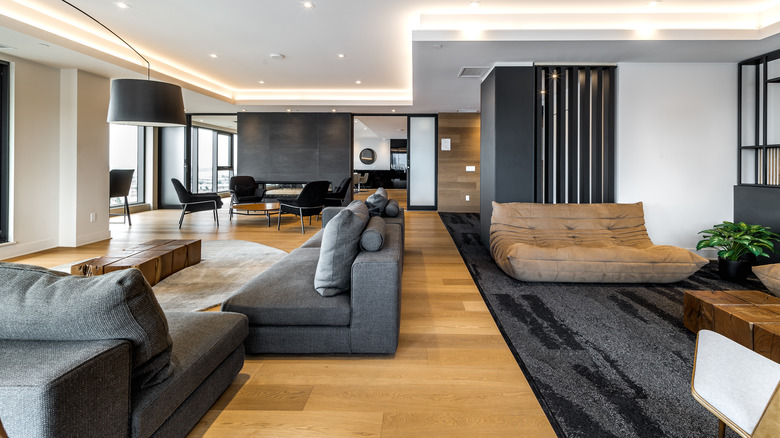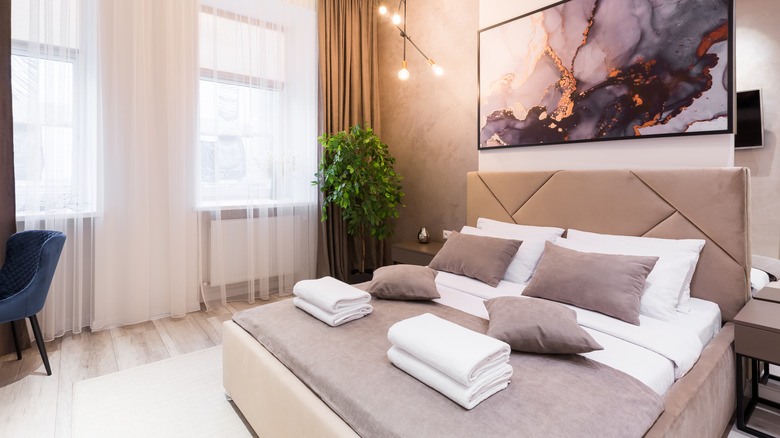Do Clients On Love It Or List It Get To Keep The Furniture?
Many home transformation shows on HGTV offer incredible renovations, often incorporating everything from new additions to the home to innovative designs and styles. One thing you're surely likely to see in completed episodes is a well-styled home, one that looks staged by a professional to create an impressive look perfect for TV.
The details of HGTV shows aren't always revealed to the public. Many episodes don't show a lot of the behind-the-scenes work that's done or how long the project took to complete. When watching shows like "Love It or List It, " some viewers have questions. For example, it's pretty hard to believe every show will result in couples squared off against each other, initially hating the renovation of their home, then ultimately being impressed by the outcome. In nearly all projects, the furniture is staged impressively, sometimes with designer features and always with just the right amount to make the space look beautiful, leaving many people to wonder if the clients get to keep it all.
"Love It or List It" typically breaks down a significant amount of the costs for the work done on each home as part of their process, such as an estimated cost of repairs based on the long list of requests from the homeowners. Viewers don't often get to see the details though, including whether all of the furniture in the home is a part of the renovation or if it's just staged for the viewers to fall in love with it. Who pays for the furniture on "Love It or List It," then?
Homeowners pay for their renovations
On "Love It or List It," money is often a big point of conversation throughout the episode. It's often a key discussion cliffhanger when interior designer Hilary Farr has to go back to the property owner to ask for more funds for unexpected expenses. There's no direct answer from HGTV about what's included in the price tag that property owners are presented with, as viewers don't typically see a detailed breakdown of costs. However, homeowners are expected to pay for all renovations, which becomes obvious when there are negotiations about upgrades and homeowners need to provide more money or give up on some components of the project to meet higher costs elsewhere. We just don't know how much covers labor and materials, for example.
That would imply homeowners are responsible for the cost of furniture added to the home during the renovation, especially considering how uncommon it is to see the designers return the furniture previously in the home. That ugly green couch in the living room and the stained table in the kitchen don't tend to make it into the final part of the episode. That certainly would tarnish the transformation if it were to happen. So what happens after the show wraps and the homeowners move back into the home? There are some claims that, because there's no way the design team can finish everything in the short time allotted, some renovation extras are done solely for staging purposes and are removed when filming is finished.
Clients typically get a choice
After the show ends, homeowners on "Love It or List It" are given a choice. They can keep the furniture that's on-site if they want to do so, or all of the staged pieces can be removed. If they decide to keep it, they'll pay for it. The one element we don't know when it comes to this process is whether or not the cost of furniture is built into the original estimate presented by Hilary Farr during the makeover. Whatever renovations the team does to the home remain in place. They don't typically remove things like islands or appliances. It's safe to assume those are included in the actual renovation budget. The art on the walls, furniture, and that gorgeous bedspread, though, probably won't stay unless the homeowners pay out of pocket for them.
Furthermore, HGTV does not cover the cost of temporary living expenses for the homeowners while the team works on the home, as the Virgin Daily Island News reported. They also don't foot the bill of packing up and moving all of the belongings out of the home, either. Even more fine print? Some shows require a renovation budget of at least $100,000 and being willing to give up some control over the design.


